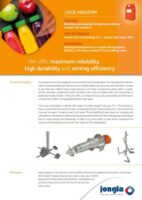
Fuel oil
Fuel oil is a fossil fuel consisting mainly of residues from the distillation of crude oil. It is mainly used in steam boilers in power plants, aboard ships and in industrial plants. Fuel oil is viscous at room temperature, so commercial fuel oil is usually blended with other petroleum fractions to achieve the desired viscosity and flash point.

Maximum performance at minimum power input

The production of fuel oil
Fuel oil is extracted from crude oil to meet specifications for a specific use. Fuel oil is then divided into two major categories, namely residual oil and distillate oil produced in the combustion process.
Fuel oil is chemically enhanced with dispersants and antioxidants to meet the specific requirements of the application. Fuel oil often consists of a mixture of petroleum hydrocarbons.
This fuel oil is chemically enhanced with dispersants and antioxidants to meet the specific requirements of the application. There is also fuel oil that consists of a mixture of methane sequences that typically contains 10-16 carbon atoms per molecule.
Fuel oil market trends
The global fuel oil market is mainly driven by the heavy oil market. The black oil market is mainly driven by the Middle East. In that region, there is a growing demand for crude oil for export to other countries. High maturity product markets include the United States, Australia, Canada and Europe. The United States depends on imports from Canada and East Coast Russia. Regions with high growth potential include Brazil, Chile and South Africa. Within the Asia-Pacific region, India, Korea and Singapore are the main export regions, exporting large quantities to the other countries in the region. In Latin America, Brazil is the net exporter of the product to other countries in the region.
The fuel oil market size was valued at $163.3 billion in 2019 and is expected to reach $227.2 billion by 2027, growing at a CAGR of 4.19% from 2020 to 2027.
Frequently Asked Questions
What is fuel oil?
Fuel oil is a fossil fuel primarily made from the residues of crude oil distillation. It is utilized in steam boilers for power generation, on ships, and in industrial facilities. To achieve desired viscosity and flash point, it’s often blended with other petroleum fractions.
How is fuel oil produced?
Fuel oil is derived from crude oil and is categorized into residual and distillate oil. It undergoes chemical enhancement using dispersants and antioxidants to meet specific application requirements. Additionally, it can contain methane sequences with 10-16 carbon atoms per molecule.
What drives the fuel oil market?
The global fuel oil market is mainly influenced by the heavy oil sector, particularly in the Middle East, where demand for crude oil is increasing. The U.S., Canada, Europe, and Australia represent mature markets, while Brazil, Chile, and South Africa show significant growth potential.
What are the market trends for fuel oil?
The fuel oil market was valued at $163.3 billion in 2019, with expectations to reach $227.2 billion by 2027, showcasing a CAGR of 4.19% from 2020 to 2027. The increasing demand for crude oil exports contributes to this growth.
What regions are the largest consumers of fuel oil?
Major consumers of fuel oil include the United States, Australia, Canada, and Europe. Emerging markets in South America and the Asia-Pacific region, particularly India, Korea, and Singapore, are also significant, often exporting large quantities within their areas.
Petrochemical Industry Contacts

Tom Pruymboom
Sales Director
Area Worldwide

Jan Siert Tjeerdsma
Project manager
Technical Specialist
Petrochemical – Related Articles

The Double Acting Axial Flow Turbine type AST-MTE mixing element
Operation of an AST-MTE Element Operation of an AST-MTE Element This element can be used in both CW (clockwise) and CCW (counterclockwise) directions. In one case, the inner AST element is downward-pumping with the outer tips pumping upward, and in

Jongia Mixing Technology Agitators in Process Installations
This reactor setup from Veenbrink RVS, equipped with Jongia agitators, forms the foundation for polymer production. The system is applied in an ATEX classified zone: the equipment zone 1 IIB T2, whilst the space itself is designated as zone 2

A New MD for Jongia Mixing Technology!
Leeuwarden, 23 April 2025 We are delighted to announce that we have a new Managing Director at Jongia Mixing Technology! Our new MD is Mr. Jean Philippe Pfeiffer. Jean Philippe has worked for De Dietrich for 29 years as Group








